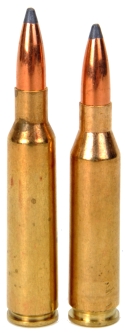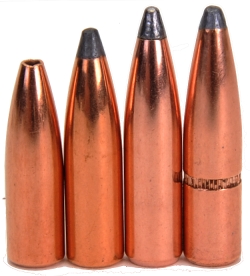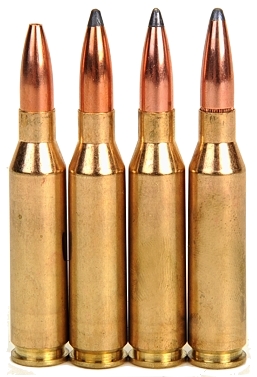
The handloading exercise with the 6.5×55 Swedish Mauser yielded good results and workable fall hunting season component combinations. However, there were also a couple of assumptions made that I wanted to prove out before moving on to the 260 Remington. “Joe, you’re rambling here. What does that mean?” Gees, let up, will ya. Here’s is an example…
| Cartridge Comparisons | |||||
| Cartridge | Case Diameter “ |
Case Length “ |
Overall Length “ |
Grains Capacity “ |
Measured Capacity* |
| 6.5x55mm | 0.480 | 2.165 | 3.150 | 57.0 | 58.5 |
| 260 Remington | 0.471 | 2.035 | 2.800 | 53.5 | 52.8 |
| * Average of 20 once fired, full length resized cases. | |||||
The 6.5x55mm begins life as a component case with roughly 10% greater capacity than the 260 Remington, however, respective cartridge maximum COL influences net case capacity. A properly seated and very long 140 grain Berger VLD yields a 6.5x55mm net case capacity of 51.6 grains and a 260 Remington case capacity of 45.1 grains. Software simulation suggests that at a uniform 60k PSI, the 260 Remington will produce 2,685 fps and the 6.5x55mm, 2712 fps.
“Ah, Hah! ” you say… because I certainly wouldn’t, “With that type of capacity differential, the superior Scandinavian cartridge would surely out scoot that Johnny-Come-Lately American pretender by… theoretically, 27 fps. Substituting a Norma, Lapua or Woodleigh heavyweight of approximately 160 grains would yield essentially the same result. But enough of this muzzle distance performance. Theoretically, what might that velocity differential look like to Bullwinkle out to 500 yards?
|
140 Grain Berger VLD Performance |
|||||||
|
Cartridge |
Yards |
0 | 100 | 200 | 300 | 400 | 500 |
| 260 Remington | Velocity – fps | 2685 | 2544 | 2408 | 2276 | 2148 | 2025 |
| 6.5x55mm Swedish | Velocity – fps | 2712 | 2570 | 2433 | 2300 | 2172 | 2048 |
| 260 Remington | Energy – ft.-lbs. | 2241 | 2012 | 1802 | 1610 | 1434 | 1275 |
| 6.5x55mm Swedish | Energy – ft.-lbs. | 2286 | 2053 | 1840 | 1644 | 1466 | 1304 |
| 260 Remington | Trajectory | -1.5 | 2.8 | 1.6 | -5.5 | -19.4 | -40.8 |
| 6.5x55mm Swedish | Trajectory | -1.5 | 2.7 | 1.7 | -5.2 | -18.7 | -39.6 |
 With an ordinate of 3″ or less, the point blank range for the 260 Remington would be 273 yards. Point blank range for the 6.5x55mm would be 276 yards. I’ve seen greater differences caused by primer brand selection. Therefore, I submit that the 6.5x55mm dimensional advantage amounts to bupkis, nada or niente… dependent upon where you grew up in New Jersey.
With an ordinate of 3″ or less, the point blank range for the 260 Remington would be 273 yards. Point blank range for the 6.5x55mm would be 276 yards. I’ve seen greater differences caused by primer brand selection. Therefore, I submit that the 6.5x55mm dimensional advantage amounts to bupkis, nada or niente… dependent upon where you grew up in New Jersey.
The 6.5x55mm with its 20.5″ barrel and greater case capacity would seem to hold an advantage over the 20.0″ barrel 260 Remington, however, neither cartridge would achieve 100% powder burn. Consequently the extra fuel carried by the 6.5x55mm would be expelled at the muzzle in unburned form, adding nothing to pressure persistance and velocity. Wouldn’t the 6.5x55mm benefit from its 0.500″ longer barrel? Who keeps asking me these questions? Actually, because 6.5″x55mm cartridge is longer, the net bore length is only slightly longer than the 260 Remington barrel; 18.440″ 20.5″ barrel, versus 18.290″ for the 20″ barrel 260 Remington.
Theoretical conclusion
The 6.5x55mm Swedish is an excellent cartridge that holds no ballistic advantage over the 260 Remington in any configuration or bullet weight. However, the the 260 Remington can be chambered in light weight and compact firearms, including something based on an AR10. So why do I own a full stock CZ 550 6.5x55mm Swedish Mauser? Because it is a beautiful rifle with an excellent shooting and hunting personality and it is at least the ballistic equivalent of a 260 Remington. So, Joe, you grumpy old duffer, why then do you also own a Remington Model Seven chambered for the 260 Remington?” Because it is light, fast handling and more durable within a hunting environment and it will produce about the same ballistics as the 6.5x55mm Swedish round.
Theoretical meets empirical… sort of

| Brand | Mfg # | Type | Grains | Construction | Length “ | B.C. |
| Sierra | 1710 | HP | 100 | Lead Core | 0.934 | 0.259 |
| Sierra | 1720 | Spitzer SP | 120 | Lead Core | 1.082 | 0.356 |
| Nosler | 16320 | Partition SP | 125 | Lead Core | 1.175 | 0.449 |
| Hornady | 2620 | Interlock SP | 129 | Lead Core | 1.175 | 0.445 |
Above are the four bullets used to create the 6.5x55mm Swedish Mauser baseline in Part 1: L-R: 100 grain Sierra Varminter, 120 grain Sierra Pro-Hunter, 125 grain Nosler Partition, and the 129 grain Hornady Interlock.

Above, what these cartridges look like when assembled within the confines of the 260 Remington (left) and 6.5x55mm cartridge overall length specifications. These were loaded to the same pressure levels for each cartridge, 60,000 PSI. The 6.5x55mm data can be found in Part 1. Below, is the companion data for the 260 Remington.
 |
Warning: Bullet selections are specific, and loads are not valid with substitutions of different bullets of the same weight. Variations in bullet material and length will alter net case capacity, pressure and velocity results. Primer selection is specific and primer types are not interchangeable. These data represents maximum loads in our firearms and test equipment and may easily be excessive in other applications. All loads should be reduced by 3%, and developed following safe handloading practices as represented in established reloading manuals produced by component manufacturers. Presentation of these loads does not constitute a solicitation for their use, nor a recommendation.
|
||||||||||||||||||||||||||||||||||||||||||||||||||||||||||||||||||||||||||||||||||||||||||||||||||||||||||||||||||||||||||||||||||||||||||||||||||||||
|
|||||||||||||||||||||||||||||||||||||||||||||||||||||||||||||||||||||||||||||||||||||||||||||||||||||||||||||||||||||||||||||||||||||||||||||||||||||||
And? And?
I would have to say my pressure persistence and unburned fuel theory, while well thought out and logical in appearance, just doesn’t hold up. The 6.5x55mm Swedish Mauser with its greater capacity and longer action length, even in relatively short barreled rifles, outperforms the 260 Remington. With the exception of a couple of data fliers, the benefit is greater as bullet weight increases.
| Bullet Type | Bullet Weight |
6.5x55mm Velocity FPS |
260 Rem Velocity FPS |
260 Rem +/- FPS |
| Sierra HP | 100 | 3168 | 3126 | -42 |
| Sierra HP | 100 | 3297 | 3154 | -143 |
| Sierra HP | 100 | 3107 | 3088 | -19 |
| Sierra SP | 120 | 2971 | 2956 | -15 |
| Sierra SP | 120 | 2947 | 2981 | +34 |
| Sierra SP | 120 | 2975 | 2961 | -14 |
| Nosler Partition | 125 | 2994 | 2860 | -134 |
| Nosler Partition | 125 | 2977 | 2842 | -131 |
| Nosler Partition | 125 | 3033 | 2889 | -144 |
| Hornady | 129 | 3010 | 2798 | -212 |
| Hornady | 129 | 2938 | 2725 | -213 |
| Hornady | 129 | 2941 | 2820 | -121 |
Judging from primer appearance, the 260 Remington was working hard to deliver these numbers. Switching to factory ammunition or loading to the 6.5x55mm 50K PSI spec, the 260 Remington would have the clear performance advantage, regardless bullet weight.
Does this mean the Remington Model Seven is on its way out? No, not at all, The reason for having rifles in both chambers had nothing to do with common ballistic performance. The reason each was selected, CZ 550 for appearance and Model Seven for utility is as valid as it was before I began the project.
The 260 Remington Versus the 6.5×55 Swedish Mauser Part 1
The 260 Remington Versus the 6.5×55 Swedish Mauser Part 2

Email Notification